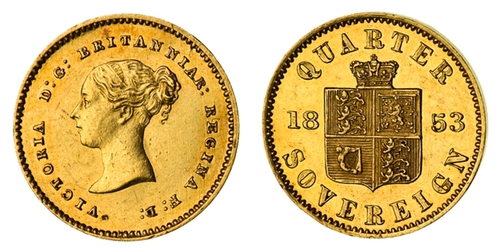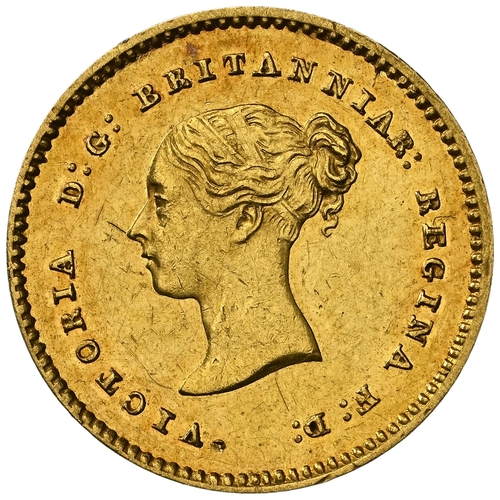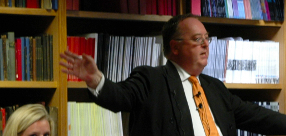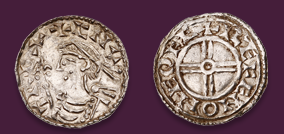Auction: 25005 - The Carrington and Pallas Collections of Exceptional English and Anglo-Gallic Gold Coins and Proof Sets
Lot: 433
(g) NGC PF61 | Victoria (1837-1901), Pattern for a Quarter-Sovereign, 1853, under Sir John Herschel, Royal Mint [London], struck from the Maundy Twopence die, by Leonard Charles Wyon after William Wyon, VICTORIA D: G: BRITANNIAR: REGINA F: D:, small young head left, rev. struck en médaille, QUARTER - SOVEREIGN, crowned quartered Shield of Arms, dividing 18-53 across field, edge plain, 1.986g [30.649grns], 12h (Hocking 2205; BMC E.3589; W&R 365 [R4]; Douglas-Morris 186 this coin; Montagu 1590; Murdoch 522-523; Nobleman 288-289; Norweb 614; King 214 = Peh 1171 [PCGS SP63]; Baumhauer IV 1886 [NGC Details]; EGC II, 1306 [R4]; G P Dyer, p. 77, Fig. 1), a pocket-piece memento from the height of Victorian experimentation at the Royal Mint in pursuit of Decimalisation, with contact marks to rims and fields and further scuffing on portrait, otherwise brilliant, with an 'afterglow' of orange hues attractively ensnaring the peripheries, strictly very fine / extremely fine, yet OF THE HIGHEST RARITY, only TWELVE struck of this and the 'FIVE SHILLINGS' variety (presumably in pairs of 6) recorded on Mint Accounts in August 1854, with an historic chasm until the next Quarter-Sovereign being issued by the Royal Mint in 2009, in NGC Black 'Pallas' holder, generously graded PF61 (Cert. #8534315-003)
Provenance
The "Pallas" Collection of English Coins
Seaby, by private treaty (ref. 743032), 13 April 1975
SCMB, February 1975, G104* - "VF/EF, very rare" - £775
Captain K J Douglas-Morris, Sotheby, 26 November 1974, lot 186* - "very fine to extremely fine, very rare" - £540 [Seaby]
SCMB, April 1956, G447* - "good EF, RRRR" - £42.10.0
SCMB, March 1955, G381 - "good EF, RRRR" - £42.10.0
The Palace Collection of Egypt, Sotheby's, 27 February 1954, lot 829 [part] - "Victoria, Maundy threepence and penny, 1838; pattern quarter sovereign, 1853, edge plain; Jubilee model half farthing, 1887, with Gothic head; and a small gold (10ct.) medal of St. George and Dragon. The first four brilliant and very rare" - £55.0.0
King Farokh
A H Baldwin, by private treaty with King Farokh, c. 1935
Virgil Michael Brand († 1932), collection dispersed posthumously
Nobleman, Sotheby's, 27-31 March 1922, lot 289* - "brilliant and very rare" [Spink for Brand]
Royal Mint, by private treaty with Private Collectors, by 1871
The surviving transcripts discussing the advent and trial of a gold Five Shilling Piece during the reign of Queen Victoria, to mirror those coining activities of the reigns of George I and George III is enlightening. Much as in, 1718, or 1762, the economy was faced with a shortage of available silver specie. Despite raising output three-fold after the Mint Reforms of 1851, the run on the Bank of England was unable to keep up with the hydropsical public demand for money totalling upwards of £100,000 a day in the Spring of 1853. Paradoxically, the pre-existing silver Crown Piece barely circulated, being favoured by neither the wealthy, nor the poor as a practical store and exchange of value. In and of itself, this explains why the Gothic Crown was never struck as anything more than a Pattern issue in 1853, and equally why the Young Head Crown issues terminated in 1847. With the Mint's further preoccupation with striking Gold Sovereigns in the first quarter of 1853, the survival of many of the at least 4 million emissions is also As is borne out by the subsequent Parliamentary enquiry, a reasoned explanation is provided for the repurposing of a Maundy Twopence obverse die [an evident cost and time-saving measure] as well as the deployment of a plain edge for this Mint trial. The impracticalities of such a denomination from a production and seigniorage perspective as well as the emergence of the gold Dollar in the United States ultimately prompted its abandonment; the fear being too great that costly re-issues would need to be undertaken to continue to protect the staple Sovereign exchange in commerce. As if to beautifully illustrate James Wilson's fears, the present example, beautiful and scarcely handled as it is, is already on the cusp of demonetisation on account of its fractional weight depreciation of three-quarters of a grain on the Full Sovereign.
House of Commons, Monday 18 April 1853 (London Express, refers.)
EDWARD DIVETT asked the Secretary to the Treasury whether arrangements were in progress for giving a better supply of small coin?
JAMES WILSON said the inconvenience which had arisen, and which still existed, with regard to the mintage of this country he admitted was of the highest importance. They had complaints every day of serious inconvenience by bankers and merchants from every part of the country. But when he informed the house that two years ago the highest amount of coin that could possibly be turned out of the mint was 210,000l. a week, and that by the extraordinary exertions of those by whom the Mint was conducted, the present out-turn was now upwards of 600,000l. weekly, he thought that statement would show the house that whatever inconvenience might be suffered by the public, the authorities connected with the Mint had not been lacking in their duty. During the first three months of the present year there had been no less an amount coined than 4,335,000l. in gold, and 92,000l. in silver, and the whole number of coins including silver and gold turned out of the Mint for the three months of the present year was 6,000,100. It appeared to him that this accelerated rate was quite inadequate to the present demand. The demand for the last days at the Bank of England had been equal to 100,000l. of coined gold per day, which it was utterly impossible for the Mint at the present moment to turn out, and therefore what they were to do with regard to silver unless some cessation of the demand for silver took place he did not know. With regard to half-sovereigns, it was obvious that the number of coins was two to one, and the difficulty was increased by half-sovereigns. The Master of the Mint's attention was directed to the subject, and if nothing else would do they would work day and night, but then the difficulty would be to get the metal assayed.
BENJAMIN DISRAELI asked if the report of the Master of the Mint had been laid on the table.
JAMES WILSON said there was no report from the Master of the Mint on the subject, but if the Right Hon. Gentleman would move for a report it should be laid on the table. There had been a paper moved for already as to the amount of coinage in the last three months, which would be presented this evening.
BENJAMIN DISRAELI observed that if there was no report it was impossible for him to move for it.
EDWARD DIVETT asked whether any project had been discussed as to the expediency of coining quarter sovereigns to obviate to some extent the want of silver pieces.
JAMES WILSON replied that that had been discussed, and it had had their attention so far that he had requested the Master of the Mint to have a die cut, in order to make the experiment. There were a variety of reasons against it, and there were a great many reasons for it. There was an American gold dollar issued lately, which would perhaps not be an adequate reason against it, but the great reason was that every pound required four coins, and the labour, therefore of coining quarter sovereigns would be quadrupled, as compared with coining sovereigns.
The discussion became the purview of The Select Committee on Decimal Coinage, which reconvened on the matter on the 3 May 1853:
CHAIRMAN: Your objection to the fourpenny-piece is not as being inconvenient, but because it too much resembles the three-penny piece? - That was my reason for it.
SIR WILLIAM CLAY: You have already expressed an opinion as to the expediency of calling in the half-crown pieces; have you thought at all whether it is possible to continue the crown pieces? - I believe that, practically, the crown piece is of very little use; there are very few people, even rich people, who like to carry about a crown piece, and, I believe, practically, the poor never use them. I believe that at the Bank of England, the circulation of crown pieces is extremely small.
Your belief is, from the information you have at the bank, that there are very little used at the bank, and are very little applied for? - Very little applied for.
Do you see any objection to making a gold piece of the value of 5s? - I believe, so far as the public are concerned in the more ordinary transactions of payments, it would be a very great convenience; but there are practical inconveniences which I will state to the committee, having put them down upon paper in consequence of the statement made by the Secretary to the Treasury, Mr Williamson, that the reason against the issue of quarter-sovereigns was, that there was an American coin of nearly the same size and value; also that the coinage of them would be attended with four times the expense of the coinage of a sovereign. In addition to those objections there are others which he did not state, or, perhaps, did not consider of equal gravity.
These coins must circulate either for their actual value as quarter-sovereigns, and therefore, be of a specific weight and fineness, or as tokens, as the silver coins circulate.
Supposing they were to circulate as the sovereigns do, they would be very expensive coins, not only in the fabrication, but to the public in their circulation, inasmuch as they would require, from the beginning to the end, exactly the same treatment, and would go through the same routine as the sovereign, although only a quarter of its value.
A sovereign, at the present time, passe out of circulation when it has lost one-and-a-half per cent of its value, or about three-quarters of the grain in weight.
It may be said, why not allow a sovereign to pass current at a much lower rate? Why not allow a diminution of 3d or 4d within its circulating limits?
The answer is, that in this case a fraudulent diminution of the coin would be profitable; at present it is not. A person skilful enough to reduce the weight of twelve new sovereigns to a point just within their current weight without defacing them, by which he would gain about 1s, would be able to earn in the same time almost double the sum, and this without the twelve sovereigns or the delicate weighing implements and other tools required in the fraud.
The sovereign is the basis of our money, and therefore the necessity of keeping it up to its weight. This is a great practical difficulty, even with the sovereign, and is greater with the half-sovereign and the cause of much trouble and loss to the actual traders. At present the coinage is in a very good state, and sovereigns are seldom weighed by shopkeepers; the risk of loss is so small, that they prefer it to that of losing a customer.
This good state of the gold coinage, as to weight, is to be ascribed to the weeding it is constantly undergoing in its passage through the Bank of England. Each piece is there weighed singly, and the light coins are cut, and returned to the party tendering them, who has to bear whatever the have lost by abrasion during their existence as coins.
The loss of the whole of the gold coinage of this country is about £6,000 per annum.
The proportion of light coins in the present gold circulation is about three-and-a-half per cent, and for the half-sovereigns about two per cent.
If quarter-sovereigns were coined the loss to the ultimate holder would be near four per cent; or else they would not remain so long in circulation. In each coin, there would only be nineteen-hundredths of a grain for wear, and that allowance could not be safely increased. It is true sovereigns do, especially in country places, circulate for a long time after they have fallen below the current weight; but it would not be proper to make them a legal tender in their reduced condition, for the reasons before mentioned
The quarter-sovereign therefore, would not only cost more than four times as much as a sovereign in its fabrication, but the expense also of its circulation, and its withdrawal from circulation, and ultimate loss to some part of the public, which loss is not borne evenly, would be quadrupled.
With regard to its circulating, as a token, there is very little to be said. In a token, the cheaper the material the better, all other points remaining the same. The sixpence and all the other silver coins how thin soever they may have worn, if they carry the undeniable marks of authenticity upon them, are accepted for their original legal value, unless they have been wilfully defaced.
It would not pay to scrape down sixpences and shillings, but small gold coins might be "sweated" as it is technically called, and two or three grains might be got from each by that process without injuring their circulation value; and that loss would fall upon the Government.
CHAIRMAN: Do you happen to know whether any objections exist in the United States to the golden dollar, either as regards the expense of circulation, or as regards the convenience of the public? - I am not practically aware of any inconvenience with regard to the expense; but I have heard objections made as to the smallness of the coin, and that persons find they are exposed to loss on that account. I made some inquiries last year of Mr Lawrence, the American Minister, and requested him to ascertain how far that was the case; and I think. he confirmed that opinion, that it was considered by many an inconvenient coin, on account of the size. The same objection would not exist to the same degree to the 5s, as to the dollar, which is 4s. I beg leave to say that these objections I have made refer rather to the objection on account of the expense; but practically to the public, I think the coin would be a convenience, and have always thought so.
J B SMITH: The silver coins being tokens, the loss by abrasion is borne by the Government, is it not? - Yes.
Suppose you make all the smaller denominations of gold coins merely tokens, would the Government be liable to the loss, or would the public? - The Government, in that case, would be liable to the loss. If it were not necessary for the protection of the taker that they should be of a certain weight, that result would follow, as is practically the case with all our token coinages; nobody thinks of weighing shillings or half-crowns.
Do you see any inconvenience in having our gold coins under the value of a sovereign similar to our silver coins, merely passing as tokens? - I have always thought it a great hardship upon the public that the last holder of a gold coin is subject to all the loss arising from the wear and tear of the coin while passing through various hands. In France the Government bear the loss of the abrasion of the coin; and I have frequently discussed that subject with gentlemen connected with the Mint in Pais, and they have always considered it was only just to the public that the Government should bear the loss arising from reasonable wear and tear. The objection raised by our Government has always been that it would subject them to extensive frauds; but the reply given to me at the Mint in Paris, that it was the business of the Government to prevent fraud.
SIR WILLIAM CLAY: Do the French Government charge a seigneurage on the coin: - It is the case that a small charge is made for the seigneurage.
J BALL: Do you not think the adoption of the suggestion would lead to extensive frauds by what is called the artificial sweating of the coin? - I do not think it would to any material degree.
Do you think the ordinary law sufficient to prevent the fraudulent abrasion of coin; is it not very difficult of detection? - I think it would not be more just than the present mode of saddling the whole expense upon the accidental last holder; for practically the public are unable to test the actual weight of a sovereign. Though it is quite fair to saddle them with the expense of taking a forged coin, I think it is not fair to saddle the last holder with the whole expense of the wear and tear which may have been spread over some 20, or 25, or 30 years, without his having any practical mode of being able to detect the error. No one in the ordinary transactions of life can practically weigh a sovereign.
Is it not the case in the south of Europe, that the Governments have found it practically impossible to carry out the system you suggest, and that in some cases the Government departments have found it necessary not to receive coins that appear to have been artificially reduced, and that hence arise continual contests as to whether such and such a coin has or has not been improperly dealt with? - I have never had any experience of that kind myself, nor was I aware that such a practical difficulty existed.
Are you aware that in Spain, it has been found necessary to put special marks upon the gold coins, in order to determening for what value they should pass? - I was not aware of that fact.
Would not the abrasion in the small gold coin, for instance, the half-sovereign, be greatly reduced by not having milling the edge? - I have thought that the present system of milling the edge is an aggravation of the evil of abrasion to a great extent, and it is highly objectionable. Every coin has now a file at work, rubbing off the edges of the coin next to it, when thrown in any way together.
In November 1853, a reader wrote to the Editor of the Illustrated London News, commenting: "Many persons suppose a smaller gold coin than the half-sovereign would be useful; but it is objected that a golden quarter sovereign would be so small, that the hard hand of a working man or labourer would be scarcely able to feel it. In America, there is the gold as well as the silver dollar; the objection is there made of its smallness; and it is the intention of the American Government to make it larger, by having a large hole in the centre, so that the coins may be strung together upon a string; this plan would also be found useful for the small silver coin of 10 cents."
https://www.ngccoin.uk/certlookup/8534315-003/63/
Subject to 20% VAT on Buyer’s Premium. For more information please view Terms and Conditions for Buyers.
Sold for
£6,000
Starting price
£2500











